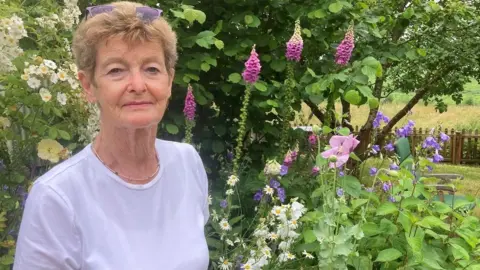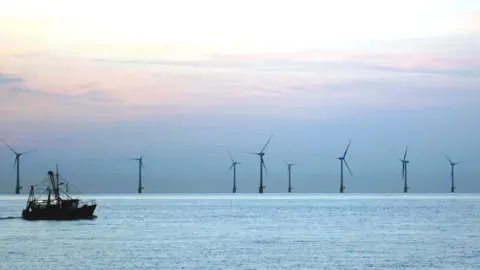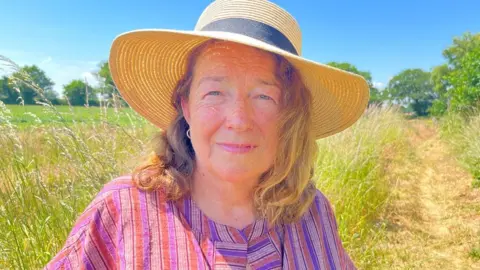Fears that Suffolk electricity substation could blight village
 Liz Thomas
Liz ThomasA woman says plans for a electricity substation and cable work near her home is proving a blight on the community and has hit house prices.
National Grid, which is behind the plans for the substation , says it is needed to bring off-shore wind power energy from the East Anglian coast.
Liz Thomas, of Friston, near Leiston, Suffolk, has joined a group campaigning against the plans.
BBC Politics East is holding a special debate on the "energy coast" on Sunday.
 PA Media
PA MediaMrs Thomas, who has lived in the village for 12 years, said the National Grid plans could see a cable trench running straight past her house.
The power lines would come ashore at Aldeburgh from the large windfarms off the Suffolk coast, in the constituency represented by Environment Secretary Therese Coffey.
She said homes in the village have lost value due to the plans.
"I have close neighbours living down the road from me," said Mrs Thomas, who is part of Suffolk Energy Actions Solutions (SEAS) - which is campaigning against the plans.
"They wanted to move but had to cut the price of their home by £75,000 and that was a direct result of the development that is going to happen in the village.
"They were advised by an estate agent [that the plans for the substation] was an influential factor."
 Richard Daniel/BBC
Richard Daniel/BBCFiona Gilmore, who is also involved in SEAS, said instead an offshore electricity grid should be built, similar to one already operated by Belgium.
She said the National Grid should not be "desecrating unspoilt countryside" at Friston for "power needed in London".
 Martin Giles/BBC
Martin Giles/BBCThe shallow waters and sandbanks off East Anglia are in line for huge expansion of wind power.
Separate to the proposed substation at Friston, National Grid plans to build a new line of pylons, more than a hundred miles long through Norfolk, Suffolk and Essex, in a project formerly known as East Anglia Green, but now known as Norwich to Tilbury.
There has been huge opposition. All three county councils have condemned the plans.
Most progress has been made in the energy sector as polluting coal-fired power stations were shut down.
In 1990, some 22.2% of our electricity came from relatively low-carbon or renewable sources. That rose to 54% in 2022.
However, delays have made the ongoing job of cutting the UK's carbon emissions harder, according to one of the world's leading climate change research centres at the University of East Anglia in Norwich.
Regardless of whether the cables are put on land or carried down to south Essex and London via an offshore route, Asher Minns, executive director of the Tyndall Centre for Climate Change Research, said: "There is still everything to play for and it's not too late either, but we have to speed up work."
 Richard Daniel/BBC
Richard Daniel/BBCThe boom in offshore wind also presents huge economic opportunities too. Especially for students at East Coast College in Lowestoft in Suffolk.
Bailey Woolston, a second year apprentice with Scottish Power who is studying at the college, said: "I'm really excited for the future.
"There are many windfarms in the pipeline and I would like to be involved in the construction of the next one."
 Richard Daniel/BBC
Richard Daniel/BBCRachel Bunn, who runs the college's commercial training and is also a director for the East of England Energy Group (EEEGR), said: "These are very exciting times.
"I have lived in this area for 46 years and I have never known so much opportunity for young people, but also for adults wanting to retrain."
She said with any developments there was a "balancing act" between the need for the infrastructure and the concerns of communities.
"The energy sector is working with the communities and giving back to the communities," she said.
A spokesperson for National Grid said: "The country's electricity transmission network needs a number of major reinforcements to meet the government's net zero ambitions to connect large volumes of wind and nuclear generation.
"We look at a number of options when considering any new reinforcements, and we will consider and evaluate offshore alternatives where appropriate.
"As the cost of all connections ultimately goes onto the electricity bills of domestic and business consumers, the UK government and our regulator Ofgem require us to develop proposals which represent value for money to consumers."
Politics East will have a special debate on developing the " energy coastline" on Sunday, 25 June at 10:00 BST on BBC One and available after broadcast on the BBC iPlayer.

Follow East of England news on Facebook, Instagram and Twitter. Got a story? Email [email protected] or WhatsApp us on 0800 169 1830
